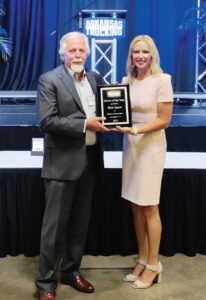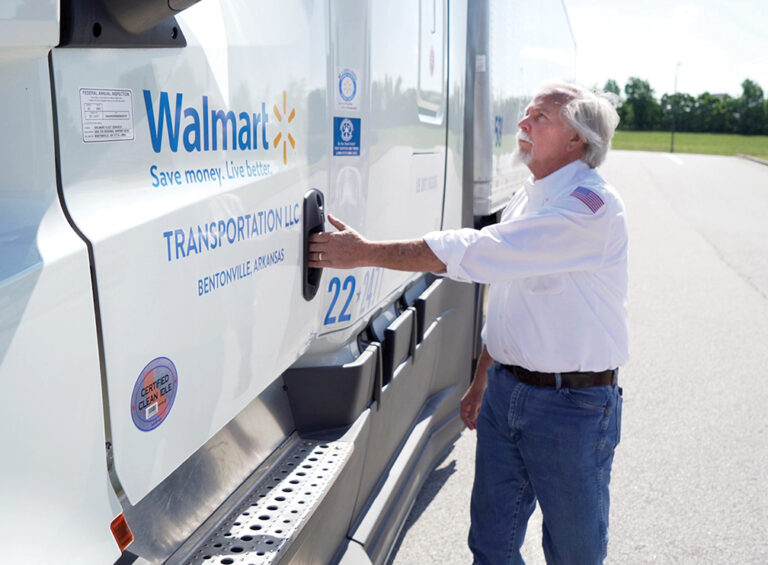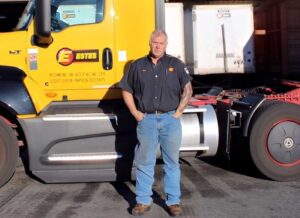Ask Wyatt Jepsen what led him into the trucking industry, and he’ll tell you getting behind the wheel was a move made out of necessity.
“I was working construction, and it just got to be ‘hit and miss.’ I saw an ad to become a truck driver and I signed up for it,” he said. “I went and took their course and away I went. I’ve been pretty much driving ever since.”
The reasons behind Jepsen’s entry into the business might not have been particularly dramatic, but today — almost four decades and millions of miles later — he’s got quite a few stories to tell.
The latest story is the one about the time, back in May, when he was named 2021 Driver of the Year by the Arkansas Trucking Association.

“It was extremely moving,” he said. “It was such a neat experience. It was just a lot of fun, and it meant the world to me to be honored with that.”
Jepsen, who now lives in Arkansas with his wife Vicki, grew up on a cattle ranch in Utah. Truth be told, ranching was his first love in life. However, he says, his parents discouraged him from carrying on the family operation, citing the hard work and uncertainty of a life in agriculture.
“I grew up on a ranch with horses and cows and absolutely loved that lifestyle, but when my parents grew up in it, it was a rough living for them,” he said. “They discouraged me from continuing that, so I left home and went to college for a little while — and that wasn’t for me. So, I started working construction; then from there (I went) to driving.”
Jepsen started his driving career with North American Van Lines; then he “bounced around a little” between company driver gigs and being an owner-operator before taking a job with Arkansas-based Walmart Transportation. Nearly three decades later, he’s still driving for Walmart.
“What has changed the most is our size. We are so big now. When I started, we were a real small distribution center. We only had about 30, maybe 40, drivers out in Utah,” he said of his time with the giant retailer.
“We have worked extremely hard on the transportation side to maintain the culture — which, if you know anything about Walmart, the culture that Mr. Sam (Walton) built was so important,” he continued. “I think the transportation side of Walmart has worked harder at maintaining that culture than any other division, and it is extremely hard to do when you’ve got over 11,000 drivers.”
Two elements of that Walmart culture — innovation and thinking like an owner — are exactly what Jepsen and his cohorts employed a few years back to improve fuel efficiency.
“Fuel (prices)got so high back in 2008 our boss asked us to take on a project,” Jepsen said. “He wanted to get the guys that had the bottom fuel mileage to just bring it up a little bit, and so we started doing research.
“The only way we could get the information was download right off the ECM of the trucks to get an accurate reading, and we started giving that information to the drivers,” he shared. “Every month we would give our drivers what their mileage was and it challenged them to do better. Nobody wanted to be on the bottom of the list”
In today’s world that strategy doesn’t sound like much, especially with all of the data at one’s fingertips. But 14 years ago, it was a laborious, analog project.
“On my truck today, I can tell you my mileage for a long period of time or I can tell you what it was for today. I can keep track and tell you exactly on my tablet how many gallons of fuel I use in a day,” he said. “The way we were getting it before, we would plug into the ECM and download the data off the truck and when we came back here to a meeting, we brought stacks of data from the downloads. We had a stack of them probably a foot high.”
The effort paid off locally: The team gained more than a mile per gallon, enough to catch the eye of the home office.
“After that, Walmart started sending us around to other locations getting other people involved in it,” Jepsen said. “It was just a fabulous time to be involved with that.”
The other aspect of company culture and personal ethics Jepsen has carried with him is serving those in need. As a member of Walmart Transportation’s emergency response team, he’s traveled to areas of crisis to deliver critical supplies. In the past year, he’s supported relief efforts in Louisiana following Hurricane Ida by delivering and manning a mobile pharmacy, allowing locals access to medications. He also delivered food to Mayfield, Kentucky, in the aftermath of tornadoes, remaining there for several weeks to help cook for people in the community.
“Hurricane Ida was my first long deployment,” Jepsen said. “It was quite an experience to see the devastation. What stood out to me was the resilience of the people in Louisiana. Those people live down there knowing eventually they’re going to face a hurricane. They knew a week ahead of time it was coming and had a little bit of time to prepare — and they did.”
Victims of natural disasters are not always fortunate enough to have prior warning.
“Those poor people in Kentucky, when they woke up Friday morning, they had no idea that they were going to lose everything that night,” he said. “They were in shock when we got there.”
Jepsen still drives for Walmart, he but has other roles with the company, including serving as a driver trainer and testing new on-board equipment. The pace has slowed since the days he touched all the lower 48 states, and he has racked up 3.5 million miles without an at-fault accident.
But he’s just as proud of a job well done as he ever was.
“I’m extremely proud of my record,” he said. “The traffic and everything, the way it is now — there’s so much more of it, and there’s so much more distraction. The people who are driving, it’s really getting hard. I feel sorry for the new drivers coming in because it is quite unforgiving out there compared to 30 years ago. But as I like I tell them: One mile at a time is the only way you can drive.”
Dwain Hebda is a freelance journalist, author, editor and storyteller in Little Rock, Arkansas. In addition to The Trucker, his work appears in more than 35 publications across multiple states each year. Hebda’s writing has been awarded by the Society of Professional Journalists and a Finalist in Best Of Arkansas rankings by AY Magazine. He is president of Ya!Mule Wordsmiths, which provides editorial services to publications and companies.














